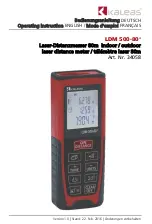
Remote Operation
Manual 31470, Rev. E, April 2001
3-33
3.2.18
Averaging
SENSe:AVERage
Averaging is applied during normal operating mode. In the normal mode, Avg
n
results in
n
x 192
samples taken. In the Swift or Burst modes, Avg
n
results in 2
n
samples taken. Auto averaging takes 4
samples all the time. For auto averaging in the normal mode, the averaging number is level dependent
with very low averaging at +20 dBm, and many samples taken at very low levels.
Syntax
:
SENSe<sensor 1 or 2>:AVERage:COUNt
space<1,2,4,8,16,32,64,128,256,or 512>
Example
:
OUTPUT @Pwr_mtr;SENS1:AVER:COUN 16
! Set sensor 1 average number to 16
Description
: This command averages successive sensor readings in a digital averaging filter. As the
measured signal level approaches the noise floor of the power sensor, measurement data
values begin to fluctuate. To measure very low signal levels (within a few dB of the sensor
noise floor), set a large value for averaging such as 128, 256, or 512. Be sure to zero the
sensor, CALibration:ZERO, prior to critical measurements.
Syntax
:
SENSe<sensor 1 or 2>:AVERage:COUNt:AUTO
space<ON or OFF>
Example
:
OUTPUT @Pwr_mtr;SENS2:AVER:COUN:AUTO ON
! Select sensor 2 Auto-Averaging mode
Description
: Auto-Averaging optimizes the measurement averaging value for reading stability and
update rate when the measurement data is being repeatedly updated. At high power
levels (measured), minimum averaging is applied to optimize measurement speed. As the
power level drops, additional averaging is applied to steady the measured data reading.
Syntax
:
SENSe<sensor 1 or 2>:AVERage:TCONtrol
space<data acquisition averaging method,
MOVing or REPeat>
Example
:
OUTPUT @Pwr_mtr;SENS1:AVER:TCON REP
! Set sensor 1 to acquire fresh
! measurement data before averaging
Description
: The SENSe:AVERage:TCONtrol commands are instrument level commands that control
the internal measurement data averaging of the power meter. Two modes are selectable,
MOVing and REPeat.
The MOVing control applies the current measurement to the previously measured data.
That is, even if the averaging number is 16, you will get a measurement data point every
time a sample is taken, not just after every 16 samples. There is some limited built in level
sensing capability. For example, when Auto-Averaging is used and the power is suddenly
changed from a low value to a high, MOVing averaging throws out the very low level previ-
ous data as the gain range changes and begins averaging fresh data. Thus, wide abrupt
changes in power level are not masked by the MOVing averaging. The 8650A can fully
range in about 4 ms. MOVing averaging is similar to TR1 mode in typical benchtop power
meters.
REPeat averaging performs full averaging every time the 8650A is triggering. Unless the
averaging number is set to 1, REPeat is slower than MOVing averaging. REPeat control is
similar to TR2 mode in typical benchtop power meters. Fresh data is measured and aver-
aged with each complete measurement cycle.
Summary of Contents for 8650A Series
Page 4: ......
Page 12: ...Series 8650A Universal Power Meters viii Manual 31470 Rev E April 2001 ...
Page 16: ...Series 8650A Universal Power Meters xii Manual 31470 Rev E April 2001 ...
Page 18: ...Series 8650A Universal Power Meters xiv Manual 31470 Rev E April 2001 ...
Page 20: ...Series 8650A Universal Power Meters xvi Manual 31470 Rev E April 2001 ...
Page 32: ...Series 8650A Universal Power Meters 1 12 Manual 31470 Rev E April 2001 ...
Page 198: ...Series 8650A Universal Power Meters 3 124 Manual 31470 Rev E April 2001 ...
Page 216: ...Series 8650A Universal Power Meters A 8 Manual 31470 Rev E April 2001 ...
Page 228: ...Series 8650A Universal Power Meters B 12 Manual 31470 Rev E April 2001 ...
Page 240: ...Series 8650A Universal Power Meters Index 6 Manual 31470 Rev E April 2001 ...
















































